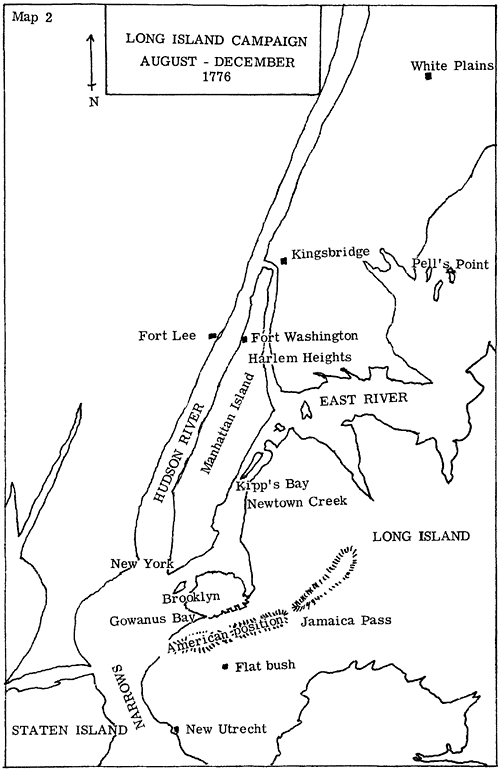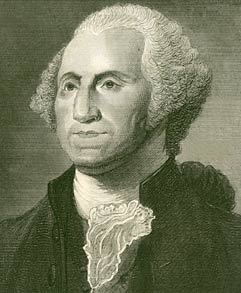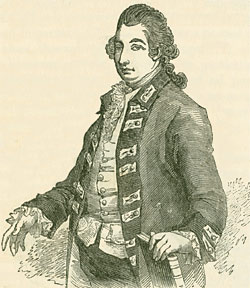Sir Henry Clinton's War, Long Island and New York, 1776-1777
The autumn of 1775 was a very frustrating time for the British commanders who lacked information about their opponents, or where they could expect support. Until some clear idea emerged it was very difficult for the British Commander, now Sir William Howe, to decide where military intervention would be most effective in support of the loyalists. The American forces besieging Boston continued to grow, and at the beginning of March 1776 occupied and fortified the Dorchester peninsula. This threatened British communications, and it was decided to evacuate Boston. On the 17th March the British forces left Boston for Halifax, Nova Scotia.
In the meantime Sir Henry Clinton had been detached with 2,000 men to join reinforcements arriving from England and to attack and capture Charlestown, South Carolina. The expedition was a complete failure from the British point of view. A naval bombardment of the fort on Sullivan's Island guarding the harbour entrance was completely ineffective. Clinton's force landed to capture the Island was in fact put ashore on Long Island, and discovered that contrary to information they could not cross between the two Islands as expected. They became mere spectators of the action which followed.

Three frigates which were supposed to aid a diversionary attack against Hadrell's Point ran aground; so the attack had to be abandoned. The British withdrew on the 28th June, and the ships reached the British base of Sandy Hook near New York on the 31st June. Sir Henry Clinton and his men then re-joined the main British force for the next campaign. [For a more complete account of this incident see the article 'The Battle for Sullivan's Island 1776', by M. Foster Farley, in History Today, 26, 2 (1976) pp. 83-92]
Long Island and New York, August 1776-May 1777

George Washington (1732-1799)
From The Popular History of England by Charles Knight, Vol. VI (London: Bradbury and Evans, 1860)
On the 22nd August 4,000 British troops under Earl Cornwallis and Sir Henry Clinton were ferried from Staten Island to Long Island, where they were quickly joined by a further 5,000 troops. By noon of that day almost 15,000 men had been put ashore. Against scattered resistance the British pushed inland as far as Flatbush and established a camp.
Washington was unconvinced that the main British effort would be made against the American lines at Brooklyn, but he did send reinforcements across under Israel Putnam. The American lines were established on the hills now known as the Brooklyn Heights between the British and American camps. This ridge was densely wooded, and Washington was convinced that it could be held with a thin line of troops. The obvious lines of attack were either along the coast road bordering Gowanus Bay or through the Flatbush or Bedford Passes. Sir Henry Clinton had reconnoitered the extreme left of the American position, Jamaica Pass, and found that it was held by only five men. The British plan was made accordingly, and although usually accredited to Sir William Howe contained a good deal of Clinton's thinking.
The attack against the American lines was carried out in three sections. Diversionary attacks were launched against the American right and centre but the main British force under Generals Clinton, Cornwallis and Howe with 10,000 men moved forward in the early morning of the 27th August to Jamaica Pass. They brushed aside the American patrols and at 9.00 a.m. two cannons were fired to signal a general attack on the American position. The Americans found British troops in their rear, and the retreat to the lines at Brooklyn became a rout. The British did not quickly exploit their victory but settled down to besiege the Americans at Brooklyn, which gave General Washington time to withdraw all his forces from Long Island on the night of the 29-30 August [see Document 2 for Clinton's account of these matters].

Charles Cornwallis, 1st Marquess Cornwallis (1738-1805)
From The Popular History of England by Charles Knight, Vol. VI (London: Bradbury and Evans, 1860)
At this point the British had their greatest opportunity in the War, which they failed to exploit. Washington's men were demoralised and weakened, and there was a real chance of destroying the American Army and capturing George Washington. Clinton felt that the correct move now was to capture Kingsbridge, by way of the Bronx, thereby bottling the American Army up on Manhattan Island. Washington would then have had the choices of attempting to cross the Hudson in the face of the British fleet, starving, or surrendering. General Howe on the other hand was determined on a direct attack on New York, and moved the army along the shore to Newtown Creek.
General Clinton led the assault on Kip's Bay in Manhattan, and much to his surprise the landing was unopposed. The Americans abandoned New York but slipped past the British and established themselves in force at Kingsbridge and the Manhattan Heights on Manhattan Island. The victory was not complete. On November 15th Fort Washington was secured by the British and the Americans cleared out of Manhattan, but most of the American army was able to withdraw intact.
By this time Clinton had been withdrawn from the active campaign to prepare for the attack on Rhode Island, which the British Navy wanted as a secure winter base. Despite misgivings Clinton executed the plan and rounded off a good year with a victory. Sir Henry Clinton had now developed a very clear idea that Britain had few friends in America save those that were made by very personal contact [see the numbers at the bottom of Document 2, which was a personal code between Clinton and Mellish and which refers to his new mistress].
Next page: 1777 and the northern campaign